(Quick update: Duolingo just added a huuuuge amount of grammatical explanation to every lesson, at least in French. This was one of my biggest complaints about the service, and it has been immensely improved! I’m still going through it, so I’ll update this article with comments about it as I progress, but it already looks like a great update.)
Oh, language barriers. Instigators of so much awkwardness and discomfort.
We’ve probably all studied a foreign language back in school, forgot practically everything, and kicked ourselves for never moving beyond the nuisance of monolingualism. Plenty of adults think of taking language classes, but it’s not the sort of hobby that can be approached casually; the time commitment is daunting, and conversational abilities rapidly deteriorate without attending those classes forever.
So I was rather looking forward to using Duolingo, which is a totally-free language learning program that claims to be just as effective as competing (and more expensive) programs like Rosetta Stone, and even comparable to classroom lessons with teachers fluent in that language. They’ve currently got Spanish, French, German, Italian, Portuguese, Dutch, Irish, Danish, and Swedish, and are in the process of adding several more.
It’s actually more clever than that, though; rather than simply providing language lessons, it’s simultaneously a translation tool. As you build up your vocabulary, the program presents you with (optional) real-world digital texts, and users submit their translations, and vote for the best answer. The site is actually solving two problems at once: Translating the web, and teaching languages. Major publications pay Duolingo for translation services, thereby providing the funding for Duolingo to offer free language lessons to millions. It’s just brilliant.
And I’m happy to say I’ve finally finished all the French lessons on Duolingo, from start to finish, with no previous French experience whatsoever, and was awarded this digital golden owl trophy as a reward:

I’ve been recommending Duolingo to everyone who mentions language learning ever since I first heard of it, which usually goes something like “Man, I’d love to learn another language. But I wouldn’t know where to begin.” And I tell them to start using Duolingo. About a week later, they write back to say they’re loving it.
So I’m happy to say that I can finally provide a more thorough review than “use it.” After progressing all the way through Duolingo’s French lessons, I went straight to a French language conversational get-together organized through Meetup.com to see how it all worked out, and a very clear picture has emerged of what can be expected from it.
I highly recommend it…but with a few pointers for the more troublesome areas.
A little about me and my language background
I’ve studied a few languages before; I took Spanish for 8 years, including a year studying abroad in Spain, and spent some time backpacking through Central and South America. I’m at the point of near-fluency, with exceptions for slang terms and heavy accents. I also studied 1 year of Russian, and got some practice during trips through Russia and Eastern Europe. I’ve also taught English in Taiwan in a classroom setting, and Spanish as a private tutor.
So “language expert” isn’t quite accurate, but I’ve studied and taught multiple languages over the course of many years, and this was my basis of comparison for evaluating Duolingo as a language-learning tool. So I’m comparing it to classroom learning, rather than other sites or apps (though I’ll try to add my thoughts on alternatives as I go through them).
How long did it take?
Well, I did it off and on for about 2 years, but I ran through the last 1/3 of the lessons in about 2 weeks. I was trying to make it all the way to the end for the sake of this review, so of course my knowledge of the latter half is rather shaky when compared to earlier lessons.
I would say it’s reasonable to expect that with consistent effort of maybe an hour per day, you could finish within several months, depending on how quickly you pick it up. Having prior knowledge of a similar language is extremely helpful when it comes to vocabulary, for example; knowing Spanish and English ahead of time made the jump to French much easier.
(It’ll also be even faster with a language like Spanish, where they actually pronounce the damn letters correctly, instead of French with that nonsensical silent s everywhere…)
So, can I speak French?
Kinda! I sped through the latter half of the lessons, and that’s what contained the bulk of the more challenging grammar rules, but I’m quite satisfied with the range of material it covers. I was able to get by, though I definitely need more practice on the later sections.
Duolingo runs through what appears to be the equivalent of a year or two of college language courses; it teaches you what appears to be all the grammar, and lots of vocabulary. By the time I was finished, the lessons had included 1854 words, and I’ve heard that 2,000 words is the sweet spot for conversational fluency. Not enough for reading a legal document or comprehending flowery poetry, but enough to be conversational and have a good time.
The lessons are organized into 71 groups, like this:
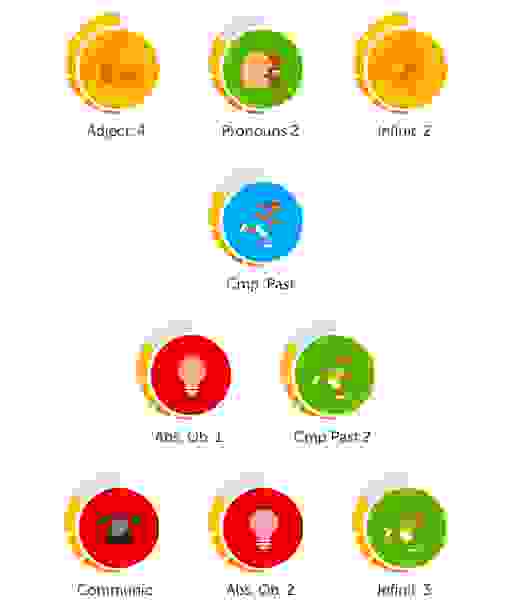
They turn gold after you complete them, and gradually deteriorate as time goes on, prompting you to repeat them to get more practice. And yes, I did in fact finish with 100% gold on everything. So HA!
Each of those sections is further subdivided into 2 to 10 lessons, like this:
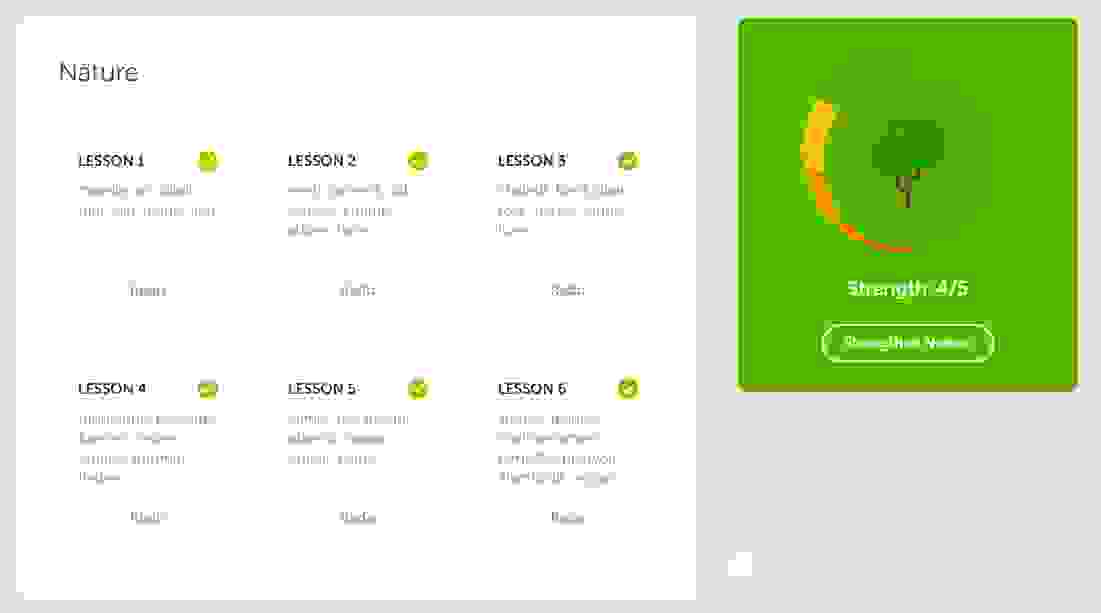
Each of those lessons includes 20 actual exercises (of one sentence each), so you can get a sense of the scale. It covers a lot.
So if you get all the way through it, you’ll be able to communicate. If you practice repeatedly until you rarely make major mistakes, you’ll be able to converse with native speakers without much trouble, except in the cases of weird slang terms or heavy accents.
So the scope of the lessons is great. Onto the details:
Things Duolingo does well
Each lesson within Duolingo includes several types of exercises, including reading, writing, speaking, and listening, in both directions (both English to French, and French to English, or whatever other language you’re learning). This is great. It covers a wide range of contexts, in which you absorb or produce sentences in whichever foreign language you’re learning.
Here’s one of the very first exercises, going from French to English:
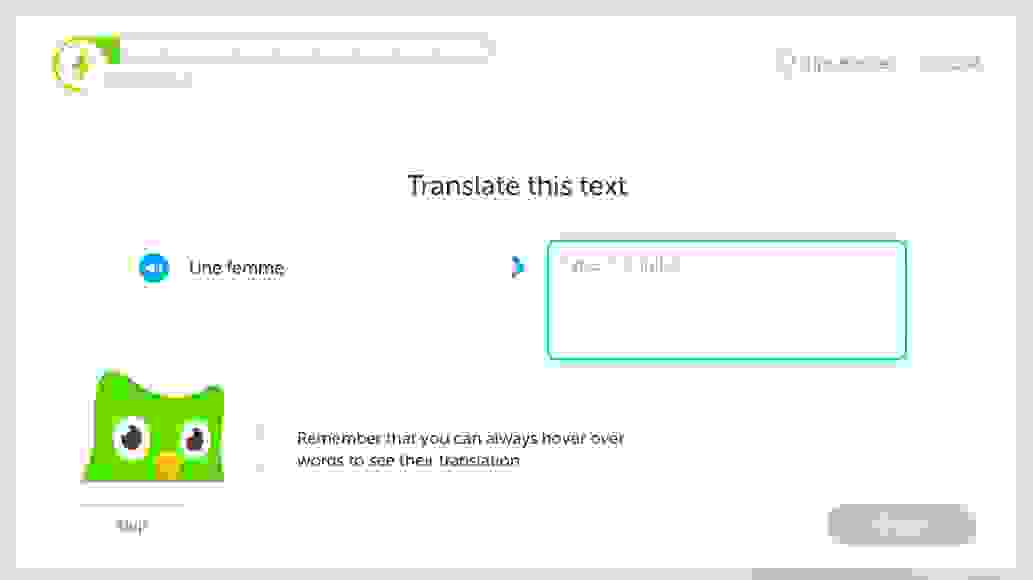
Lessons usually start with French words, so you can hover over the word to see its meaning. After running through a few of those, they’ll give you the reverse:
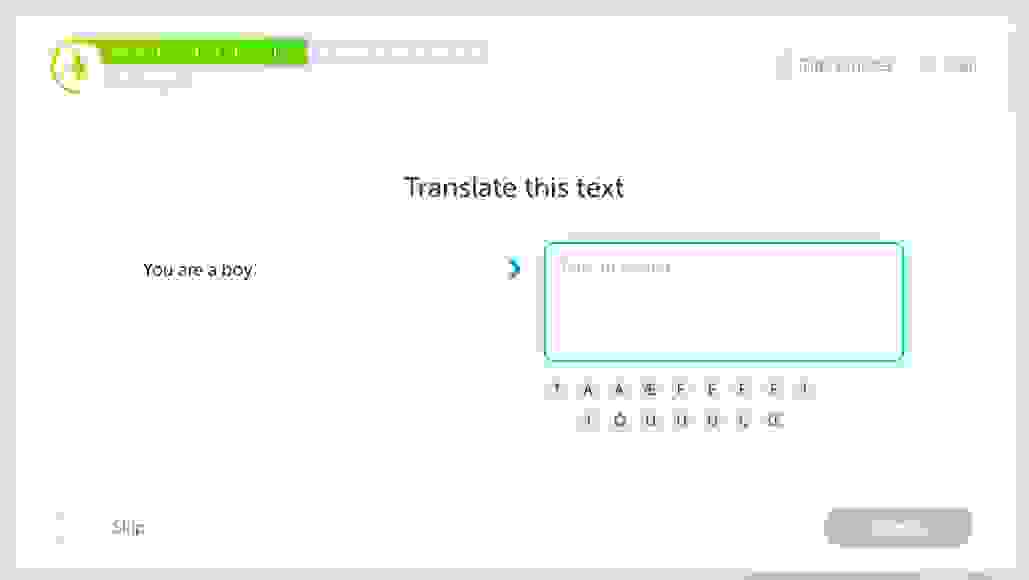
Every time you get an answer correct, that green progress bar moves forward a step; get an answer wrong, and it goes back a step. This is actually a very recent modification; it used to have Legend of Zelda style hearts, and if you lose all three of your hearts, you had to start the whole lesson all over again. The new system is a huge improvement, because you literally cannot fail, which makes it far less frustrating. You just keep trying, and you’ll get there. It seems to have doubled the rate at which I progress through these lessons. The smartphone app still has the heart system, but I expect they’ll change it soon.
They have several other types of exercises, including multiple choice, listening to a French phrase and typing what you hear, or listening to and repeating a French phrase into the microphone (although my microphone doesn’t seem to work very well, so I just switched off that feature).
The smartphone/tablet app also has a Mad Lib style exercise, where you select words already displayed on the screen, rather than typing them out. This cuts down on annoying smartphone typing (although it still has some), which makes the app a lot more usable than I was expecting:
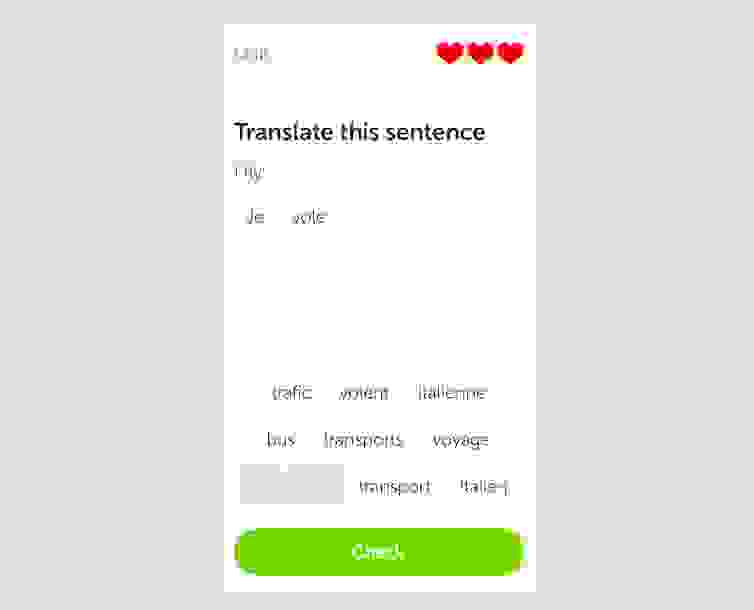
The app also synchronizes with your desktop/laptop account, so you can work on it at home, and picked up where you left off while you’re out.
The fact that it’s a program also means you can hear the correct pronunciations of every word, which, in the case of French, would be completely impossible with just a textbook.
And since it can tell you when you’ve made a mistake, you can see the correct answer immediately, so you won’t pick up bad habits and cement them for years before someone corrects you. It sometimes identifies your mistake specifically, especially if it’s just a word or two. It can’t do this all the time (particularly if your answer is just totally off), but I like that it’s sometimes able to give specifics, instead of just marking it wrong:

It also has a number of game-like elements, including leveling up, XP, bonus levels, rewards, and competitive rankings so that you can compare your progress with a friend’s (which allegedly increases your likelihood to use the program by quite a bit). I haven’t made much use of these, but I’ve heard from younger kids that they find it all quite enjoyable. It’s designed to be fun for everyone, but you can easily just ignore those elements if you don’t care. They don’t get in the way.
So if you’re wondering if it’s possible to learn a whole language just from a simple app, I would say the answer is an emphatic yes. Duolingo runs through every type of exercise you can imagine, covers a broad range of vocabulary and grammar, and offers advantages that textbook studies are incapable of providing, while simulating some of the feedback you’d get in a classroom setting, where a teacher could correct any potential errors. It’s really great.
I do, however, have some issues:
Things Duolingo does poorly
I’ve noticed the program has gone through some major design changes over the last few years, so it’s possible that some of these issues will be resolved at some point (and I’ll try to update this review if I see that happen), but, as it stands currently, here’s where you’re likely to run into trouble:
Major problem #1: No “survival” phrases at the beginning
The first few lessons in Duolingo consist of extremely simple words or phrases, so you build vocabulary gradually, one word at a time. This is great. But the specific words and phrases it teaches you in the beginning are not beginner phrases. Instead of teaching you “hello, how are you, what’s your name, where’s the toilet, how much does it cost,” and so on, it teaches you things like “he is a man, she is a woman, the apple is red, the cat is black.”
Obviously those are words you’ll want to know at some point, but it seems somewhat odd that it doesn’t stack the most-used introductory phrases up front. I was about halfway through the lessons before it covered how to ask for the toilet, and, as far as I can recall, “what’s your name,” and “my name is” were buried exclusively in the un-lockable bonus skill section titled “Flirting,” rather than being integrated into the regular lessons.
For this reason, I would say that if you’re in a huge rush to learn basic “survival” phrases really quickly in a short period of time, I would actually recommend not using Duolingo. If for some reason you have only a week or two to prepare, get a phrasebook or a cheat sheet of simple phrases and memorize them instead.
If, however, you have several weeks or months, Duolingo is a much better option. And I can kinda see why they did it this way, as the early lessons present just a couple words at a time, instead of lengthy, tricky sentences. Besides, it will eventually teach you everything you need to know; I just think it would have been somewhat more practical to place a few basic introductory phrases up front, before anything else.
Major problem #2: Very little grammatical instruction
Duolingo’s model works by throwing you right into the exercises, so you get started reading, writing, listening, and speaking right away, and the fact that it builds on existing knowledge by adding just one or two words at a time, letting you hover over a new word so you can see what it means, all add up to a system that works extremely well.
It does not, however, include comprehensive explanations of grammar rules. If you studied a foreign language back in high school, you might remember terms like subjunctive, preterite, imperfect, conditional, pluperfect, and their billion iterations when it comes to verb conjugation. Duolingo covers them, but they’ll do it with exercises, without telling you what’s going on and why.
On the one hand, I can see why they might do this; the program is trying to emulate natural language learning, by throwing you right into the middle of an immersive language experience, instead of spending time explaining when to use the preterite instead of the imperfect. That’s how kids learn.
But the people studying with Duolingo aren’t little kids. They’re most likely adults or teenagers, or maybe older kids (since you need to know how to read and type in order to use the program), all of whose brains are completely different from a toddler’s. Tiny children have an extraordinary ability to soak up language at a young age, but they’re terrible at grasping complex, abstract concepts, like what a participle is. Adults, on the other hand, are terrible at picking up foreign languages, but have a much easier time understanding those abstract concepts.
So I can understand why they may have wanted to do away with complex grammar lessons, and rely instead on simple repetition for a more “natural” approach, but it would have really helped if they had said things like “Alright, guys. This is the subjunctive. You use it when you’re talking about something that isn’t real. Like what you want to happen, or what would be sad if it were to happen. Got it? Alright, let’s get started.”
Instead, they just throw you right in, and by the time you’ve “mastered” the subjunctive lessons, you still might have no clue how to use it. If I hadn’t known it already from Spanish (since a lot of the grammar is the same), I think it would have been far more difficult.
This is, however, rather easily solvable; whenever you get to a new grammar rule that you don’t understand, Google it instead of relying on Duolingo to explain it to you, because it won’t. There are plenty of sites out there, as well as instructional YouTube videos, that will help fill the gaps. Once you get it, dive back in to Duolingo’s lessons and practice using whatever you’ve learned, and you’ll be just fine.
There’s also a little button that says “discussion” that appears at the bottom after you get questions wrong, where you can see user-submitted comments explaining the correct answer, and I would highly recommend making use of this as often as is necessary…but you can only see those comments after you submit your answer, and you also have to hope that some gracious Duolingo user has offered a useful explanation, instead of Duolingo just offering more thorough instructions at the beginning of each lesson. You’ll get some instructions, but I don’t find them sufficient for some of the more complex grammatical concepts.
It’s possible that you could learn all this merely by repetition, but I expect that looking things up and understanding them is likely to make things go a whole lot more smoothly than getting marked down for using por instead of para and having no idea why. It gets incredibly frustrating, and Duolingo mostly won’t help, other than just telling you that you’re wrong. So if you find yourself running into grammatical difficulties like these, just look them up elsewhere.
Major problem #3: Lack of repetitive drills
If you’re planning on using Duolingo to learn a Latin-based Romance language, such as Spanish or French, the worst part of all this is going to be verb conjugation. In English, it looks like this:
I go. He goes.
It’s the same verb, but it changes based on who’s doing it, as well as whether it’s in the past, present, or future (plus other factors), including variations like he went, he will go, he is going, he would have gone, and so on.
In Romance languages, it’s a billion times more complicated, and it’s really annoying.
Take a look at how many variations there are, just for a single verb, in past, present, and future:
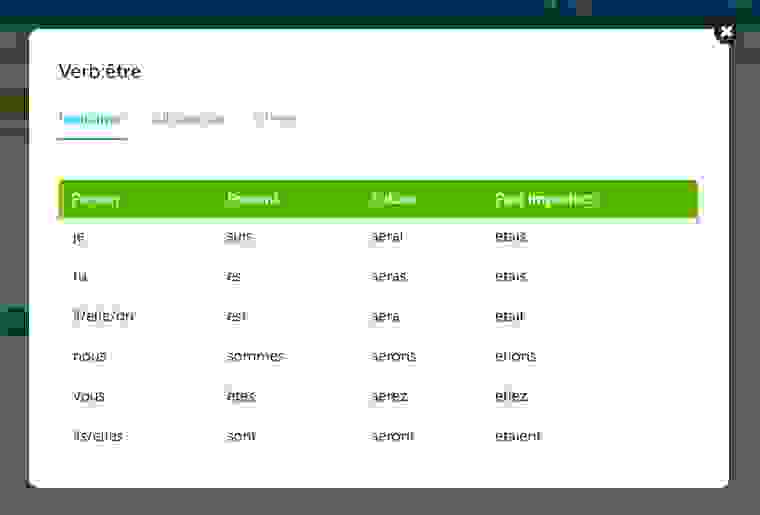
And that’s not all:
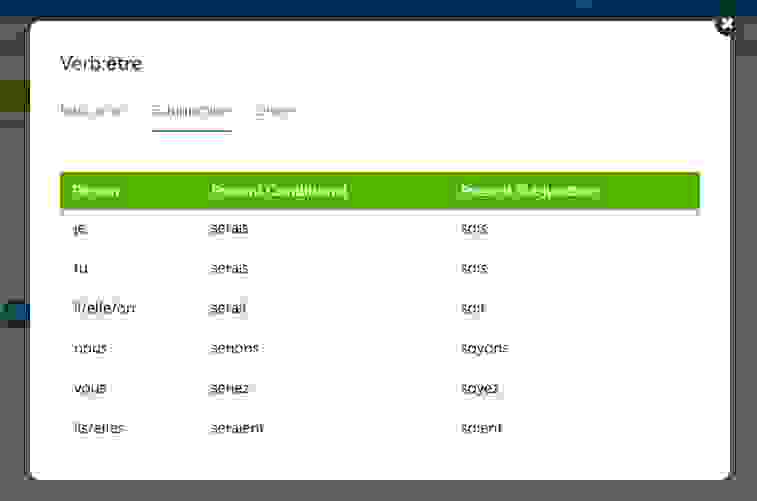
That’s still not all:
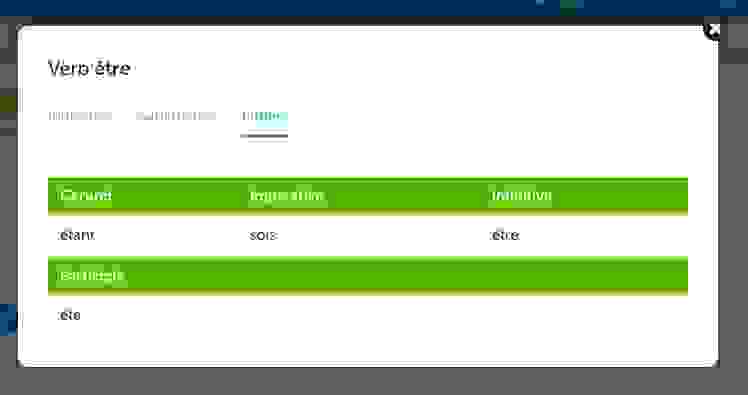
That’s a total of 34 variations, just for one verb. Imagine how difficult it is to have a conversation when you’re trying to remember which of these 34 verb conjugations is correct, and then saying the wrong one and ending up with a ridiculous miscommunication fiasco. You need to remember these quickly, or you’ll stumble all over the place.
Duolingo’s method of dealing with this is to insert these words into the standard exercises, so it’ll have sentences like he goes to the store before 9:00 on Saturday morning, and you’ll translate it, whether from French to English, or vice versa.
But that sentence had 10 words in it, and only 1 of them (goes) was the verb you needed to practice. So instead of bombarding you with highly-focused, rapid-fire verb conjugations drills, it’ll give you full sentences, which, in the case of the sentence above, would be 90% useless. It takes up lots of time, but only 10% of it was spent learning the new verb form.
Obviously it’s great to practice all sorts of words all the time, but I think in the case of verb conjugation, when you need to memorize 34 extremely similar but different verb forms and know which one to use, with perhaps a delay of 2 or 3 seconds so you’re not just standing there silently, you really need to drill them in, and I think this is where shorter, faster repetition would have been helpful.
If they just fired off phrases for you to translate like “I go, he goes, she goes, we go, they go,” and then repeated that cycle a few times, then switched to the opposite language, and repeated that cycle a few times as well, it would drill those words in a lot faster, and then it could progress to the typical, full-sentence exercises. I found myself just writing these out on paper to solidify verb conjugation exclusively, because I find the drilling to be helpful in situations like these.
Earlier lessons do this better, by the way. Those beginner exercises use much shorter sentences, consisting of maybe 2 to 5 words, which makes iteration super speedy. So they wouldn’t necessarily need to shorten the exercises down to just the verb, but shorter and faster is better.
If you’re not learning one of these Romance languages, you might not run into this specific problem at all; but I expect most other languages have their own annoying aspects, and it might not be a bad idea to devise your own repetitive drills if you run into similar problems. Another good example would be any time you have to learn a whole bunch of new words all at once. Numbers, days of the week, months of the year, seasons, and so on. It’s helpful to drill these quickly.
Again, this is a potential problem. If you just practice the existing lessons a couple more times, you’ll get that extra practice anyway. But I think speeding up the iteration time by using shorter sentences would be helpful.
Other minor nuisances
Tiny accent mark letters. Some of these languages require extra letters that aren’t present on whichever keyboard you may have (such as é and ñ), and Duolingo gives you clickable buttons on the screen so you can use those letters without having to learn new keyboard commands. But those accent marks are incredibly tiny.
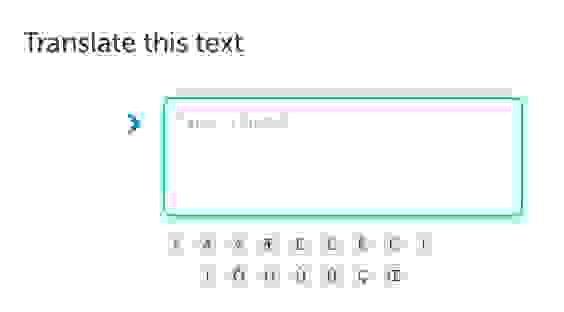
There are four different “e” options and I literally have no idea which is which. There’s maybe one pixel of difference, and it’s such a nuisance that I just don’t bother with the accents at all. They really need to make those letters bigger.
Can’t see masculine or feminine indication sometimes. One of the most annoying things about Romance languages is that nouns have gender, even if they’re inanimate objects, so you have to remember that something is called he or she instead of just it, which also affects the adjectives used to describe those nouns, because they have to match. When you hover over an English word to get its translation, it’ll show you the word, but it won’t tell you the gender, meaning you have a 50% chance of getting the entire question wrong, sometimes because of just a single letter. If they’re going to let you peek at the definition of the word so you can get a hint, they should let you see the gender as well.
Can’t see conjugation sometimes. I say “sometimes,” because for some reason, when you’re going from French to English, you can hover over a verb to see its definition, and there’ll also be a button that says conjugate:
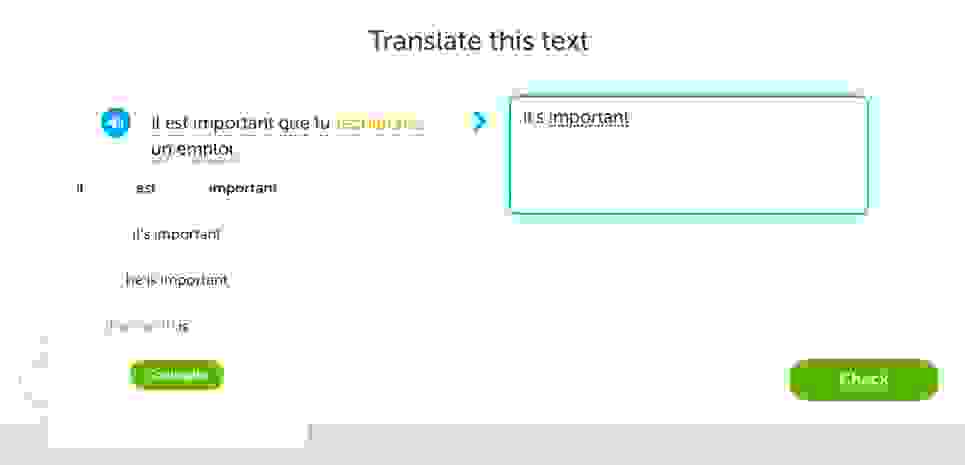
That button brings up that big verb conjugation chart showed up above, back where I was complaining about verb conjugation.
But when you’re going from English to French, you’re out of luck:
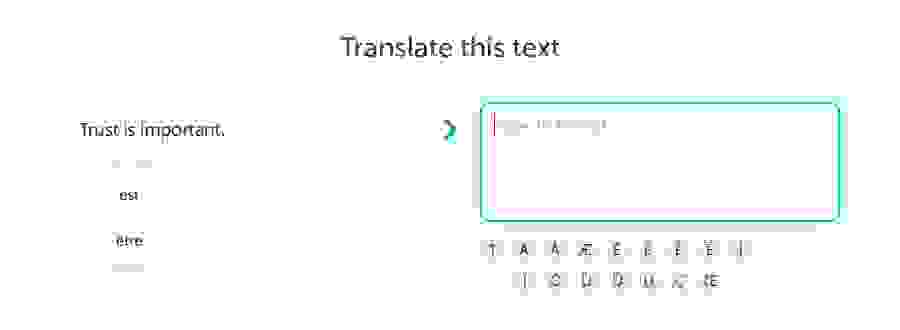
This is actually the time you need it the most, because you have to know how to spell it, too. I think it’s because sometimes there might be multiple verbs that would qualify as correct translations, so they can’t have just a single conjugate button at the bottom. But they could have a conjugate button for each verb, just to the right.
Sometimes those hover-hints aren’t correct, either. The hint gives a word-for-word translation, without taking into context the surrounding words, so it’s not always right. But, of course, it’s just supposed to be a hint, so you shouldn’t rely on it all the time.
Some answers should be accepted. Some questions have multiple correct translations, but Duolingo doesn’t know it. There’s a button if you get a question wrong that says “report a problem,” and within that, an option that says “my answer should be accepted.” This is just something that will improve with time, but it gets kind of annoying when you provide an answer that’s clearly right, and it doesn’t like it.
There should be a silent mode. You can shut off the speaking exercises so you don’t have to talk out loud, and use headphones so you’re not disturbing anyone, but I think there should be a total-silence option, at least for the smartphone app, for those times when you don’t want to put on headphones. This could just be operated by the phone’s silencer switch, or whatever it’s called. When you switch your phone to silent, the app would go silent. When you switch your phone out of silent, the app would talk again. A little pop-up in the corner could notify you when you first open the app to let you know which mode you’re in.
It’s mostly just translations. I’ve heard from some people who’ve used other language learning methods that those techniques force you to think in those other languages, rather than just translating, which requires you to go back and forth between multiple languages. Translating is important, but maybe they could add some fill-in-the-blank exercises as well.
Conclusions!
Though it may not be entirely obvious given the amount of complaining I’ve done here, I love the existence of Duolingo, and highly recommend it to everyone I meet who has any interest in learning languages.
The fact that I could go from absolutely zero knowledge of French to halfway-competent with no other instruction whatsoever, entirely for free, is absolutely spectacular. Though I was rather shaky when I first spoke with other French speakers, it was obvious from those conversations that it was just a matter of running through the existing lessons to get more practice, especially as I had sped through the latter half. You can really learn a whole language with this, and quite well.
I would say Duolingo does (at the moment) have a few shortcomings, the most significant of which are its lack of basic “survival” phrases upfront, a lack of sufficient explanations for complex grammatical concepts, and a lack of repetitive drills; I would recommend resolving these issues by Googling important survival phrases if necessary, Googling explanations of complex grammatical concepts whenever you need more detail, and conducting those repetitive drills on your own. I think I’d like to see Duolingo add these at some point, but in the meantime, it’s easy enough to supplement it with other content for free, to fill in the gaps. So by all means, use it. Just know how to handle those potential issues, and you’ll be fine.
Well, I would say it’s off to the next language, but I really need to solidify my beginner French before moving onto the next one. I’d also like to work on my Russian, which is still rather appalling (and Duolingo says they’ll add that later this year), but in the meantime, there’s another site called Babbel which has Russian lessons, and I think I’ll give that a try and see how it compares, and add some thoughts here (Update: Here’s my Babbel review!).
So, go learn something new!




This is such a well-timed review! I started using Duolingo earlier this week. Originally, I was going to brush up on my Spanish, but I got bored and headed over to French. It’s a language I’ve always wanted to learn to *pronounce*, at least. (The silent ‘s’ is the worst.) From what you’ve written here, I think I’ll probably end up stalling out when I get a few tenses in. But I do like being thrown right in with the present tense, instead of sticking to nouns and then being expected to tackle verbs all at once.
It’ll give you plenty of practice with the present, and it’ll introduce the more-frequently used past tense a little later, and that’s a good time to do those cheat sheet drills to help with memorization. But even if you stop there, it’ll still be a decent framework for getting by with it, if not necessarily saying things correctly every time.
I am not actually replying but I have the app and I am wondering in your pictures during a lesson at the top it says challenges but on mine it doesn’t have the word challenges or the bars, it only has one ong bar!
They change some of the details here and there every once in a while, so I assume that’s probably what happened.
All final “s” are silent in French (very few exceptions), since to make a sound in French you need a consonnant + a vowel.
I’m using Duolingo and Fluent Forever on Ankidroid. FF cost $20 bucks I think, but I was impressed enough with their spiele about anchoring the most important conversational survival words and phrases – which you noted DL lacks – plus teaching you to understand the accent, that I thought it worthwhile.
I studied German in high school 25 years ago, and now backpacking NZ where 80% of the other backpackers are Germans it inspired me to pick it up again.
I haven’t been too diligent with my studies, but so far about 8 days of 10-15 mins a day in each app has brought back most of what I learnt and forgot, and has improved my understanding somewhat, but conversational skills will take more effort.
For one thing I was super surprised when a cute German chick offered me a sandwich and I instinctively replied “Nein danke, Ich nicht esse brot” or some such phrase which she could understand as “No thanks, I don’t eat bread”. Something I definitely couldn’t have done after a year of high school German.
So in the end I think with the combination of these tools it’s entirely feasible to get to conversational level in a new language with less than an hour a day in under a couple months.
I’ll do a longer post on it all when I eventually get thru them and can spachen die Deutsch.
“(It’ll also be even faster with a language like Spanish, where they actually pronounce the damn letters correctly, instead of French with that nonsensical silent s everywhere…”
LOL! SO TRUE! Why can’t we just pronounce the words the way it is written?! I do not get it! Great write up and you’ve inspired me to go back to my Spanish Duolingo lessons. The problem with language though is that it’s a muscle… the less you use it the less you can. The exception to that is the languages you learn in your childhood – I can still speak Malay and Chinese fluently, even though it’s been years since I really use them extensively. Weird. Moral of the story – get your kids to pick up as many languages as possible early on!
It definitely takes repeat practice, though I’ve noticed that if you speak for a decade or so, then it does a good job of staying there semi-permanently. There’s also a lot of Spanish-language programming online; not just TV shows from Spain or Latin America, but also programs from the US changed into Spanish. I like watching documentaries in Spanish, for the practice. It doesn’t work so well with sitcoms or other fiction, because you’re missing the original pronunciation and performance of the actor, but History Channel en Español is just great.
I’ve learned an incredible amount of Spanish from watching telenovelas. Yes, the vast majority of them are horrific, trite and melodramatic, or ridiculously corny (or let’s just say ‘culturally specific humor’). Sometimes they are all of those things at the same time.
However, when you find the rare well-done one, it is engaging to the point of addiction. You won’t want to miss an episode. As you get to know the characters and all the twists and turns of the plot, novelas provide a rich context, which helps comprehension.
I am also an English major, and I have zero tolerance for junk lit or romance novels, which soap operas are in televised form, so I am surprised at myself at being able to watch them. I probably couldn’t stand to watch even the good telenovelas if they were in English or my Spanish skills were better. However, I have a true affection for the novelas and their quirks and foibles, and I recommend them highly for a fun way to learn Spanish.
I might give them a try. I’ve heard Korean dramas are getting incredibly popular too, so if anyone’s trying to learn Korean, that’s a good way to go.
I have a question. If I wanted my students a to use this APP using a class set of IPads, could my students sign into their own accounts as I have many French students and these students would be using the same IPads but want them to be able to sign into their own accounts. Thanks!
If they’re sharing iPads, they would need to sign in individually to their own account, and sign out afterwards so the next student can sign in. Just a minor hassle, but it can be done. Also, there’s a smartphone app, so if kids want to use their phones, they can do that, and maybe the people who don’t have smartphones can be the ones who use the iPads. But yes, it’ll work.
Thanks a bunch!
You mentioned wishing that you could “mute” it, and you actually can through the settings. I’ve had the mic required functions muted since September since it’s really awkward to sit in class and randomly spout sentences about a monkey and a bear eating oranges. You can also disable the speaker, voice auto-play, and sound effects and turn them back on at any time. I don’t have access to the app on a smartphone (mines a brick), but I think that if the settings are changeable on the computer, it should be possible on the app (don’t take my word).
Additionally, a site that can supplement the lack of grammar lessons to build understand of what it is your learning (for spanish at least) is spanishdict.com. First and foremost it’s a dictionary, but most things like “past”, “imperfect”, “indicative”, and “subjective” have a question mark that leads to an explanation page as to how it works. I don’t know of any for other languages (I’m only doing spanish) but for both french and spanish, I believe that explanations work in telling how the words function since they are rather similar.
Yeah, there are mute functions, but I wish they would function just with the phone’s mute button. Seems intuitive and instantaneous, instead of delving into menu systems and so on. Not a big deal, but it would be handy.
Thanks for the review.
I’m at about 40% in French and using the phone app almost always. I saw the website has a lot more detail so I may need to switch over there when conjugations get more difficult. You have given me some great suggestions for moving forward.
Merci beaucoup
Typo: “you peak* at the definition”
*peek
Typo fixed. And yeah, the website is a little more in-depth, but I think that’s appropriate for bigger screens and keyboards.
Loved your review. I just finished the French skill tree and tried to start translating a story, but every time I sign in, they send me to the tree I’ve already finished. Also, I’ve started the Spanish tree, but I still get sent to the French tree. Do you know how I can solve this problem? Is there any way to contact them?
Thanks for your attention.
Maureen
No, I don’t know how to do that…I know there’s a settings page where you get to say which language you’re learning, and maybe you can put them in order, but I’m only doing one right now, so I can’t tell if it’s an option to reorder them. Congrats on finishing, though.
oh my gosh! I also learned German via duolingo and able to read a simple children book. also post in in my blog. I encourage my friends to do so but I need a better to article for encouragement. Thank you for the post, greeting from the other side of the world
My problem with Duolingo is what happens after you finish the skills tree. After the French lessons, I went on to translating a text. Although other participants were making comments, I never new if my corrections were right or wrong. I had the same problem with a test I took. They gave me a grade, but I never knew what I had missed. I gave up on French and went on to finish Spanish and Portuguese. Today I’m starting Italian. I’m very grateful to Duolingo for giving me this chance for self-enrichment without spending money I couldn’t spare.
This is definitely a good point, which is why I think it’s important to move on from Duolingo once you reach the end of the program. It’s still great for practice, as you can solidify existing skills, but once you get all the way through the lessons, it’s time to go hang out with French speakers and watch some French movies. I still need subtitles, though…
Right, but I still would like to increase my vocabulary before trying to speak. I do watch foreign movies, but they talk too fast. I wish that that Duolingo would extend the program and give us articles to translate. Then, they could show us a copy of the translation. I need someone to tell me if I’m progressing correctly and not reinforcing mistakes.
Well I’m late as but oh well. I’d started using Duolingo maybe a year ago to learn Dutch and have gotten through less than half of the tree mostly because of the weak points you’ve outlined in your review. Even with some grammar notes clearly outlined in every module there is still a necessity for native speakers to answer a multitude of questions in the comments on individual exercises. Why not put a little more effort into the grammar lesson in the first place? Especially when a part of the tree will have 5-10 individual lessons just for random vocabulary that need to be completed to move along.
I’ve started using Memrise (also free) which a) has lessons consisting of the 1000 most commonly used words in lots of languages, which are actually useful and necessary and b) has managed to fill in some serious gaps in grammar for me despite its simple flashcard format.
Thanks for the review!
Thanks for an excellent review; it was directly applicable to my situation. I have a working knowledge of Spanish, but had literally negligible knowledge of French when I started using Duolingo for French about two months ago, in preparation for a vacation to Paris that starts in a couple of weeks. I’m about 1/3 through, and feel optimistic about being to decipher basic things when we arrive.
A few weeks ago I bought a 1 month subscription to http://www.NewsInSlowFrench.com ($15 bucks?) to help train my ears to the rhythm of the language. When I was learning Spanish I had the advantage of growing up in a city (San Antonio, Texas) where Spanish can be heard almost everywhere. I couldn’t understand much, but I knew what it was supposed to sound like. I didn’t have that advantage with French, and the little snippets Duolingo provides seemed insufficient. So I supplemented Duolingo with NewsInSlowFrench. I’m not making full use of all the ‘slow French’ capabilities because I’ve been focusing on DuoLingo.
Might you consider doing a review of NewsInSlowFrench (or one of its siblings (such as NewsInSlowSpanish?)
Thanks again for a wonderful review.